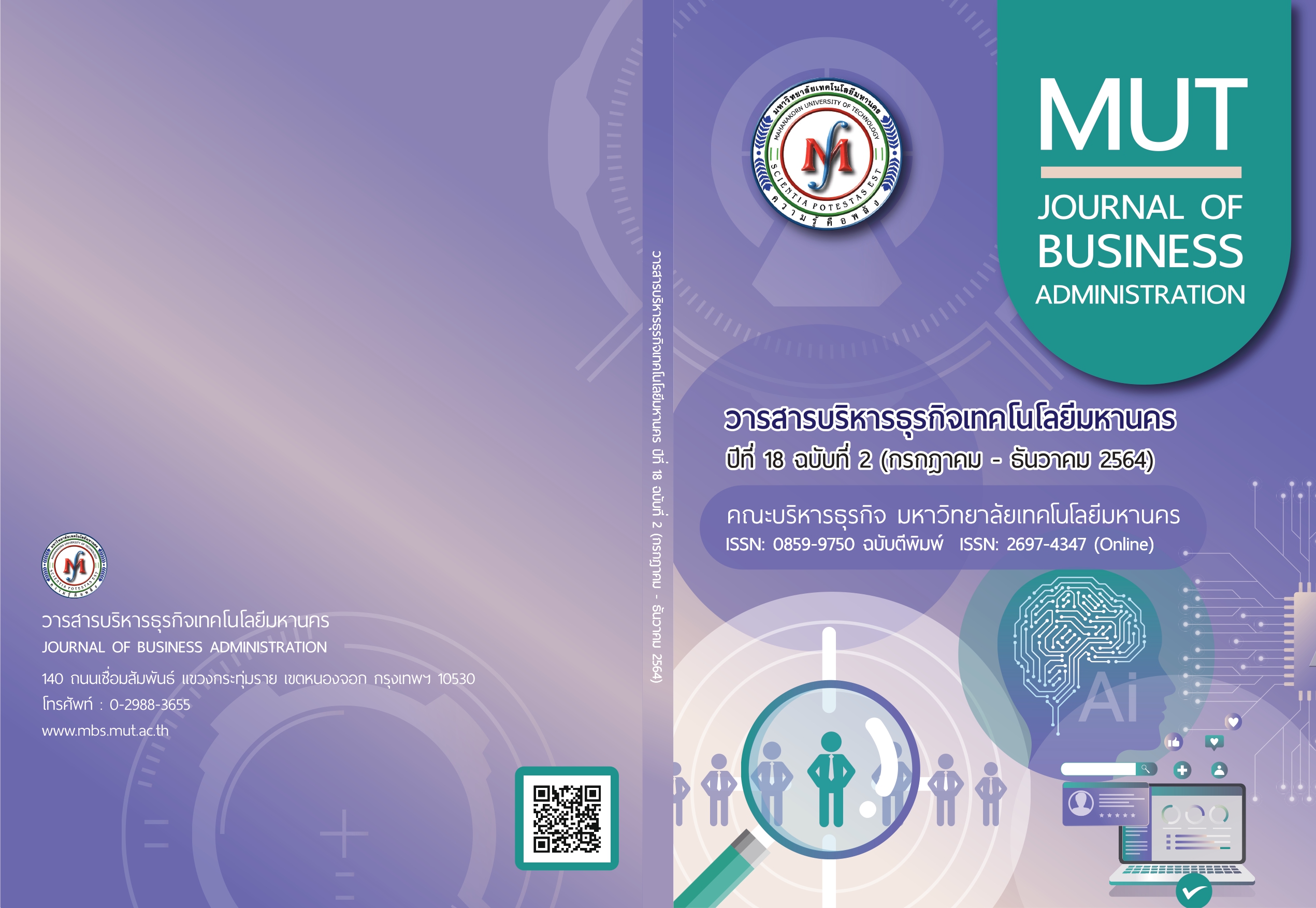Business Environment Turbulence in New Era and the Coping Concepts
Keywords:
Uncertainty, Turbulence, Early Warning, Environmental ScanningAbstract
Most business companies get used to a traditional operation. Under the unexpected situation or some crisis; which may be defined as turbulence, they will usually use the assumption of a wait and see policy until they have solid information to support their response or any decision making. However, the business environments have currently been changing much faster than in the past. Some changes can be predictable while the others may be unpredictable, resulting in severe damage for the unprepared companies. Therefore, business companies should develop a system or tools that can help reducing such risk and impact from the turbulence. In this paper, the concept of uncertainty which is the basis for uncertainty management concept and the driving forces for business turbulence was reviewed. The guideline and the tools to cope with business environment uncertainty were also proposed. Early warning and environmental scanning are the examples of these tools or techniques that may help business to identify risks or weak signals before the inflection point so that business will have more time to prepare or plan better responses.
References
Ansoff, H. Igor. 1975. “Managing Strategic Surprise by Response to Weak Signals”. California Management Review. Vol. 18 (2), 21 – 33.
Ansoff, H. Igor. and McDonnell, E.J.. 1990. Implanting Strategic Management, 2nd Edition. Cambridge, Great Britain: Prentice Hall International.
Ansoff, H. Igor and Sullivan, P. A.. 1993. Optimizing Profitability in Turbulent Environments: A Formula for Strategic Success. Long Range Planning. Vol. 26 (5), 11 – 23.
Buye, Ronald. 2021. Critical examination of the PESTLE Analysis Model. Action Research for Development : Research Gate
Chakravarthy, Bala. 1997. A New Strategy Framework for Coping with Turbulence, Sloan Management Review. Vol. 38 (2). 69 – 82.
Choo, Chun Wei and Auster, Ethel. 1993. Environmental Scanning: Acquisition and Use of Information by Managers. Annual Review of Information Science and Technology. Vol. 28. 279 – 314.
Choo, Chun Wei. 2002. Information Management for the Intelligent Organization: The Art of Scanning the Environment. New Jersey: Medford: Information Today, Inc.
Courtney, Hugh, Kirkland, Jane and Viguerie, Patrick. 1997. Strategy Under Uncertainty. Harvard Business Review. November – December 1997. 2 – 14.
D’aveni, Richard A.. 1994. Hypercompetition: Managing the Dynamics of Strategic Maneuvering. New York: Free Press.
Day, George S. and Schoemaker, Paul J. H.. 2006. Peripheral Vision: Detecting the Weak Signals That Will Make or Break Your Company. Harvard Business Review Press
Drucker, Peter. 1969. The Age of Discontinuity. 2nd Edition. New York: Routledge.
Dufva, Mikko. 2019. What is a weak signal?. Sitra. Retrived September 20, 2021 from https://www.sitra.fi/en/articles/what-is-a-weak-signal/
Embroker Insurance Services, LLC.. 2021. A Startup’s Guide: How to Navigate Business Uncertainty: Risk Management. Retrieved July 10, 2021 from https://www.embroker.com/blog/business-uncertainty/
Gilad, Ben. 2004. Early Warning: Using Competitive Intelligence to Anticipate Market Shifts, Control Risk, and Create Powerful Strategies. New York: AMACoM.
Global Intelligence Alliance. 2006. Does Your Business Radar Work?: Early Warning/Opportunity Systems for Intelligence. Gia White Paper 1. Retrieved July 10, 2021 from https://www.m-brain.com/wp-content/uploads/2015/04/10886.pdf
Greenspan, Allan. 2007. The Age of Turbulence. Adventures in a New World, EUA: Penguin Books.
Hambrick, Donald C.. 1982. Environmental scanning and organizational strategy. Strategic Management Journal. Vol. 3 (2), 157 – 174.
Hans, V. Basil. 2018. Business Environment- Conceptual Framework and Policies. International Educational Scientific Research Journal. Vol. 3 (2). 67 – 74.
Heijden, Kees van der. 2005. Scenarios The Art of Strategic Conversation. 2nd Edition. England: John Wiley and Sons, Ltd.
Ilmola, Leena and Kuusi, Osmo. 2006. Filters of Weak Signals Hinder Foresight: Monitoring Weak Signals Efficiently in Corporate Decision Making. Futures. Vol. 38 (8). 908 – 924.
Infogalactic Planetory Knowledge Core. 2021. Digital Revolution. Retrieved October 1, 2021 from https://infogalactic.com/info/Digital_Revolution
Kotler, Philip and Caslione, John A.. 2009. Chaotics: The Business of Managing and Marketing in The Age of Turbulence. 1st Edition. New York: AMACOM.
Malik, Radostaw and Janowska, Anna Anetta. 2018. Megatrends and Their Use in Economic Analyses of Contemporary Challenges in the World Economy. Research Paper of Wroctaw University of Economics. Retrieved August 29, 2021 from https://www.researchgate.net/publication/332586061_Megatrends_and_their_use_in_economic_analyses_of_contemporary_challenges_in_the_world_economy
Marcus, Alfred. 2009. Strategic Foresight: A New Look at Scenarios. Georgia: Palgrave Macmillan
Mayer, Jörg H., Steinecke, Neo and Quick, Reiner. 2011. Improving the Applicability of
Environmental Scanning Systems: State of the Art and Future Research. Governance and Sustainability in Information Systems. Managing the Transfer and Diffusion of IT - IFIP WG 8.6 International Working Conference, Hamburg, Germany, September 22 – 24, 2011. Retrieved June 11, 2021 from https://www.researchgate.net/publication/221108378_Improving_the_Applicability_of_Environmental_Scanning_Systems_State_of_the_Art_and_Future_Research
Mufudza, Tsitsi. 2018. Strategic Management: Dynamic Strategy in a Turbulent Business Environment. Intecopen. Retrieved July 10, 2021 from https://www.researchgate.net/publication/330975162_Dynamic_Strategy_in_a_Turbulent_Business_Environment
Naisbitt, John.1982. Megatrends: Ten New Directions Transforming our Lives. New York: Warner Books.
Naisbitt, John and Aburdene, Patricia. 1990. Megatrends 2000: 10 New Directions for the 1990’s. New York: Morrow.
Naisbitt, Doris and Naisbitt John. 2017, Mastering Megatrends: Understanding & Leveraging the Evolving New World, Singapore: World Scientific Publishing
Pich, Michael T., Loch, Christoph H. and Meyer, Arnoud De. 2002. On Uncertainty, Ambiguity, and Complexity in Project Management. Management Science. Vol. 48 (8). 1008 – 1023.
Porter, Michael E.. 2008. The Five Competitive Forces That Shape Strategy. Harvard Business Review. January 2008. 23 – 41.
Schoemaker, Paul J.H.. 1995. Scenario Planning: A Tool for Strategic Thinking. MIT Sloan Management Review. Vol. 36 (2). 25 – 39.
Schwenker, Burkhard and Wulf, Torsten (Eds.). 2013. Scenario-based Strategic Planning: Developing Strategies in an Uncertain World. Germany: Springer Gabler. Retrieved July 10, 2021 from https://books.google.co.th/books?id=BoPHBAAAQBAJ&printsec= copyright#v=onepage&q&f=false
Stacey, R.D.. 1992. Managing Chaos; Dynamic Business Strategies in an Unpredictable World. London: Kogut Page Limited.
Toffler, Alvin. 1970. Future Shock, New York: Random House, Inc.
Toffler, Alvin. 1980. The Third Wave. New York: William Morrow and Company, Inc. Retrieved July 10, 2021 from https://archive.org/details/TheThirdWave-Toffler
Toffler, Alvin. 1990. Powershift: Knowledge, Wealth, and Violence at the edge of the 21st century. New York: Bantam Book. Retrieved July 10, 2021 from https://openlibrary.org/books/OL1849652M/Powershift
Xu, X.M., Kaye, G.R., Duan, Y.. 2003. UK Executives Vision on Business Environment for Information Scanning A Cross Industry Study. Information & Management. Vol. 40 (5). 381 – 389.
Zimmermann, Kim Ann and Emspak, Jesse. 2017. Internet History Timeline: ARPANET to the World Wide Web. Livesceince.com. Retrieved October 1, 2021 from https://www.livescience.com/20727-internet-history.html
Zuzak. Roman. 2017. Early Warning Systems for Strategic and Crisis Management. Strategic Crisis Management Project. Retrieved August 18, 2021 from https://www.researchgate.net/publication/328282156_ EARLY_WARNING_ SYSTEM_S_FOR_STRATEGIC_AND_CRISIS_MANAGEMENT
Downloads
Published
Issue
Section
License
ข้อความ ข้อคิดเห็น ข้อมูล เนื้อหา รูปภาพ แผนภูมิ แผนผัง เป็นต้น ที่ปรากฏและแสดงในบทความต่างๆ ในวารสารบริหารธุรกิจเทคโนโลยีมหานคร ถือเป็นความรับผิดชอบโดยตรงของผู้เขียนบทความนั้นๆ มิใช่เป็นความรับผิดชอบใดๆ ของวารสารบริหารธุรกิจเทคโนโลยีมหานคร และมหาวิทยาลัยเทคโนโลยีมหานคร
บทความที่ตีพิมพ์ในวารสารบริหารธุรกิจเทคโนโลยีมหานคร ถือเป็นลิขสิทธิ์เฉพาะของคณะบริหารธุรกิจ มหาวิทยาลัยเทคโนโลยีมหานคร หากบุคคลหรือหน่วยงานใดต้องการนำทั้งหมดหรือส่วนใดส่วนหนึ่งไปเผยแพร่ต่อหรือเพื่อกระทำการใดๆ จะต้องได้รับการอนุญาตเป็นลายลักษณ์อักษรจากคณะบริหารธุรกิจ มหาวิทยาลัยเทคโนโลยีมหานครก่อนเท่านั้น


